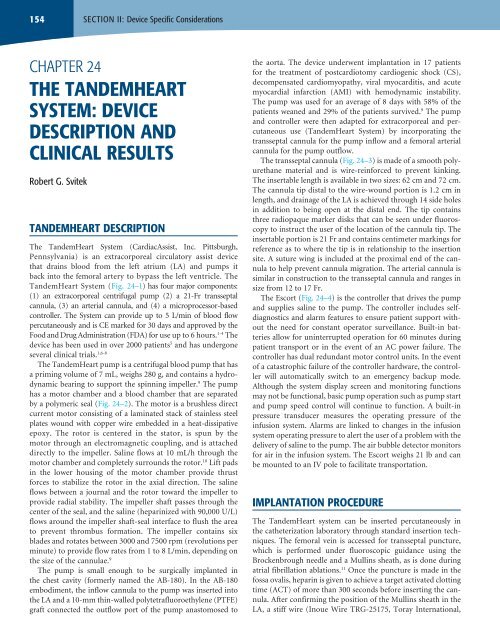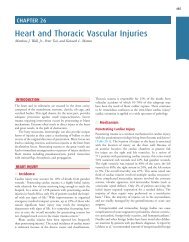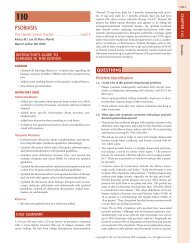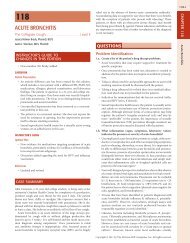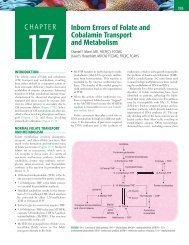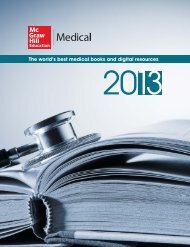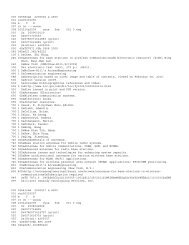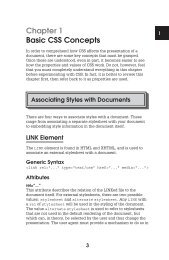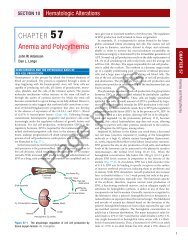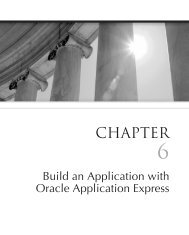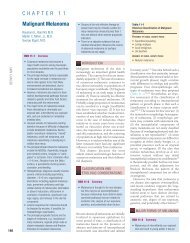THE TANDEMHEART SYSTEM: DEVICE DESCRIPTION AND ...
THE TANDEMHEART SYSTEM: DEVICE DESCRIPTION AND ...
THE TANDEMHEART SYSTEM: DEVICE DESCRIPTION AND ...
You also want an ePaper? Increase the reach of your titles
YUMPU automatically turns print PDFs into web optimized ePapers that Google loves.
154 SECTION II: Device Specific Considerations<br />
CHAPTER 24<br />
<strong>THE</strong> <strong>T<strong>AND</strong>EMHEART</strong><br />
<strong>SYSTEM</strong>: <strong>DEVICE</strong><br />
<strong>DESCRIPTION</strong> <strong>AND</strong><br />
CLINICAL RESULTS<br />
Robert G. Svitek<br />
<strong>T<strong>AND</strong>EMHEART</strong> <strong>DESCRIPTION</strong><br />
The TandemHeart System (CardiacAssist, Inc. Pittsburgh,<br />
Pennsylvania) is an extracorporeal circulatory assist device<br />
that drains blood from the left atrium (LA) and pumps it<br />
back into the femoral artery to bypass the left ventricle. The<br />
TandemHeart System (Fig. 24–1) has four major components:<br />
(1) an extracorporeal centrifugal pump (2) a 21-Fr transseptal<br />
cannula, (3) an arterial cannula, and (4) a microprocessor-based<br />
controller. The System can provide up to 5 L/min of blood flow<br />
percutaneously and is CE marked for 30 days and approved by the<br />
Food and Drug Administration (FDA) for use up to 6 hours. 1-4 The<br />
device has been used in over 2000 patients 5 and has undergone<br />
several clinical trials. 1,6-8<br />
The TandemHeart pump is a centrifugal blood pump that has<br />
a priming volume of 7 mL, weighs 280 g, and contains a hydrodynamic<br />
bearing to support the spinning impeller. 9 The pump<br />
has a motor chamber and a blood chamber that are separated<br />
by a polymeric seal (Fig. 24–2). The motor is a brushless direct<br />
current motor consisting of a laminated stack of stainless steel<br />
plates wound with copper wire embedded in a heat-dissipative<br />
epoxy. The rotor is centered in the stator, is spun by the<br />
motor through an electromagnetic coupling, and is attached<br />
directly to the impeller. Saline flows at 10 mL/h through the<br />
motor chamber and completely surrounds the rotor. 10 Lift pads<br />
in the lower housing of the motor chamber provide thrust<br />
forces to stabilize the rotor in the axial direction. The saline<br />
flows between a journal and the rotor toward the impeller to<br />
provide radial stability. The impeller shaft passes through the<br />
center of the seal, and the saline (heparinized with 90,000 U/L)<br />
flows around the impeller shaft-seal interface to flush the area<br />
to prevent thrombus formation. The impeller contains six<br />
blades and rotates between 3000 and 7500 rpm (revolutions per<br />
minute) to provide flow rates from 1 to 8 L/min, depending on<br />
the size of the cannulae. 9<br />
The pump is small enough to be surgically implanted in<br />
the chest cavity (formerly named the AB-180). In the AB-180<br />
embodiment, the inflow cannula to the pump was inserted into<br />
the LA and a 10-mm thin-walled polytetrafluoroethylene (PTFE)<br />
graft connected the outflow port of the pump anastomosed to<br />
the aorta. The device underwent implantation in 17 patients<br />
for the treatment of postcardiotomy cardiogenic shock (CS),<br />
decompensated cardiomyopathy, viral myocarditis, and acute<br />
myocardial infarction (AMI) with hemodynamic instability.<br />
The pump was used for an average of 8 days with 58% of the<br />
patients weaned and 29% of the patients survived. 9 The pump<br />
and controller were then adapted for extracorporeal and percutaneous<br />
use (TandemHeart System) by incorporating the<br />
transseptal cannula for the pump inflow and a femoral arterial<br />
cannula for the pump outflow.<br />
The transseptal cannula (Fig. 24–3) is made of a smooth polyurethane<br />
material and is wire-reinforced to prevent kinking.<br />
The insertable length is available in two sizes: 62 cm and 72 cm.<br />
The cannula tip distal to the wire-wound portion is 1.2 cm in<br />
length, and drainage of the LA is achieved through 14 side holes<br />
in addition to being open at the distal end. The tip contains<br />
three radiopaque marker disks that can be seen under fluoroscopy<br />
to instruct the user of the location of the cannula tip. The<br />
insertable portion is 21 Fr and contains centimeter markings for<br />
reference as to where the tip is in relationship to the insertion<br />
site. A suture wing is included at the proximal end of the cannula<br />
to help prevent cannula migration. The arterial cannula is<br />
similar in construction to the transseptal cannula and ranges in<br />
size from 12 to 17 Fr.<br />
The Escort (Fig. 24–4) is the controller that drives the pump<br />
and supplies saline to the pump. The controller includes selfdiagnostics<br />
and alarm features to ensure patient support without<br />
the need for constant operator surveillance. Built-in batteries<br />
allow for uninterrupted operation for 60 minutes during<br />
patient transport or in the event of an AC power failure. The<br />
controller has dual redundant motor control units. In the event<br />
of a catastrophic failure of the controller hardware, the controller<br />
will automatically switch to an emergency backup mode.<br />
Although the system display screen and monitoring functions<br />
may not be functional, basic pump operation such as pump start<br />
and pump speed control will continue to function. A built-in<br />
pressure transducer measures the operating pressure of the<br />
infusion system. Alarms are linked to changes in the infusion<br />
system operating pressure to alert the user of a problem with the<br />
delivery of saline to the pump. The air bubble detector monitors<br />
for air in the infusion system. The Escort weighs 21 lb and can<br />
be mounted to an IV pole to facilitate transportation.<br />
IMPLANTATION PROCEDURE<br />
The TandemHeart system can be inserted percutaneously in<br />
the catheterization laboratory through standard insertion techniques.<br />
The femoral vein is accessed for transseptal puncture,<br />
which is performed under fluoroscopic guidance using the<br />
Brockenbrough needle and a Mullins sheath, as is done during<br />
atrial fibrillation ablations. 11 Once the puncture is made in the<br />
fossa ovalis, heparin is given to achieve a target activated clotting<br />
time (ACT) of more than 300 seconds before inserting the cannula.<br />
After confirming the position of the Mullins sheath in the<br />
LA, a stiff wire (Inoue Wire TRG-25175, Toray International,
CHAPTER 24: The TandemHeart System: Device Description and Clinical Results<br />
FIGURE 24–1. TandemHeart System including the 21-Fr transseptal venous cannula, the extracorporeal centrifugal pump, and the arterial cannula. Blood is<br />
withdrawn from the left atrium and pumped into the femoral artery to bypass the left ventricle. (Reproduced with permission from CardiacAssist, Inc.)<br />
Heparinized<br />
saline infusion<br />
Stator<br />
Impeller<br />
Rotor<br />
Seal<br />
Fluid<br />
bearing<br />
FIGURE 24–2. TandemHeart pump cutaway. Heparinized saline flows into the motor chamber and then up into the blood chamber. Fluid forces in the lower<br />
housing act stabilize the rotating impeller axially, and fluid forces in the journal stabilize the impeller radially. (Reproduced with permission from CardiacAssist,<br />
Inc.)<br />
Blood<br />
Journal<br />
155
156 SECTION II: Device Specific Considerations<br />
FIGURE 24–3. The TandemHeart transseptal cannula comes in two sizes with insertable<br />
lengths of 62 and 72 cm. The cannula features a wire-wound construction for kink resistance,<br />
and radiopaque marker discs at the tip to aid in visualization of the tip location in the left atrium<br />
under fluoroscopy. (Reproduced with permission from CardiacAssist, Inc.)<br />
Houston, TX) is placed into the LA and the Mullins sheath is<br />
exchanged for the TandemHeart 14-Fr/21-Fr two-stage dilator.<br />
The dilator increases the septum puncture site diameter and<br />
enables the 21-Fr transseptal cannula to be inserted into the LA.<br />
The cannula tip contains three radiopaque marker disks that<br />
can be viewed under fluoroscopy to confirm that the position<br />
FIGURE 24–4. The TandemHeart Escort is a microprocessor-based controller<br />
that powers the pump and has built-in alarms and diagnostics such as flow<br />
measurement that help assess pump function. (Reproduced with permission<br />
from CardiacAssist, Inc.)<br />
of the cannula tip is in the LA. Transesophageal<br />
echocardiography has also been used to help<br />
with the insertion and cannula tip placement. 12<br />
The end of the cannula outside of the patient<br />
is sutured to the thigh to help prevent cannula<br />
dislodgement. Color Doppler has been used to<br />
visualize flow through the holes of the cannula<br />
tip to verify correct placement. 12<br />
The arterial cannula is placed in the femoral<br />
artery with the distal end sitting above the aortic<br />
bifurcation and is also sutured to the thigh to prevent<br />
cannula migration or dislodgement. Prior to<br />
arterial cannula insertion, the patients should be<br />
subjected to a femoral artery angiogram using a<br />
4-Fr arterial sheath dilator before upsizing to a<br />
larger French arterial sheath to ensure peripheral<br />
vascular disease will not prevent insertion.<br />
If the artery is greater than 5 mm, Perclose<br />
devices can be deployed to assist in achieving<br />
hemostasis following arterial cannula removal. 13<br />
Other preclosure devices have also been used<br />
to reduce arterial complications during cannula<br />
removal. 14 Additional manual compression can<br />
be employed when needed. In some patients the<br />
femoral artery is too small or too calcified for<br />
insertion of the standard cannula. Therefore, a<br />
graft can be sewn onto the femoral artery and connected to the<br />
outflow of the pump with a connector. Busch et al describe the<br />
procedure where they use a partial occlusion clamp to sew an<br />
8-mm reinforced GORE-TEX graft to the femoral artery in an<br />
end-to-side fashion using 5-0 polypropylene sutures. 15 Once<br />
the transseptal and arterial cannulae are in place, the pump and<br />
cannulae are de-aired and connected via a wet-to-wet connection<br />
to remove all air from the circuit. The pump is then connected<br />
to the TandemHeart controller, and its speed is adjusted<br />
to provide the desired level of support.<br />
UNIQUE INSERTION PROCEDURES<br />
<strong>AND</strong> PATIENT MANAGEMENT OF <strong>THE</strong><br />
<strong>T<strong>AND</strong>EMHEART</strong> <strong>SYSTEM</strong><br />
The transseptal cannula can also be inserted surgically allowing<br />
the chest to be closed for the device to be removed percutaneously<br />
following support. 16,17 The surgical cannulation uses an<br />
“open transseptal” technique when a sternotomy has already<br />
been performed. The patient is placed on cardiopulmonary<br />
bypass (CPB) through bicaval cannulation. The transseptal cannula<br />
is inserted into the femoral vein, and the tip is brought into<br />
the right atrium (RA) prior to insertion of the inferior vena cava<br />
(IVC) cannula. Placing a tourniquet around the IVC ensures<br />
adequate occlusion of blood around the CPB and TandemHeart<br />
cannulae, which are adjacent to each other. The RA is opened<br />
through the appendage, a stab wound is placed through the fossa<br />
ovalis with a scalpel, and the tip of the cannula is placed across<br />
the septum into the LA by direct visualization. The patient<br />
can then be weaned off of bypass, the atrium de-aired, and the
patient placed on TandemHeart support. Surgical cannulation<br />
of the LA has also been accomplished by placing the cannula<br />
through the right superior pulmonary vein into the LA. 17 For<br />
failure to wean patients, the IVC cannula is clamped, the snare<br />
around the IVC cannula is released, and the transseptal cannula<br />
is threaded into the RA. A small incision is made in the atrial<br />
septum and the transseptal cannula tip is pushed across. The RA<br />
is closed and CPB can be resumed or weaned as TandemHeart<br />
flows are increased.<br />
The TandemHeart System has also been placed in the axillary<br />
artery and vein to allow for patient mobility. 18 The right axillary<br />
artery and vein were exposed in a right thoracotomy. An 8-mm<br />
Dacron graft (Hemashield; Boston Scientific, Natick, MA) was<br />
sutured in an end-to-side fashion to the axillary artery using<br />
5-0 polypropylene. A wire-reinforced arterial cannula was then<br />
inserted through the graft to a point 1 cm close to the anastomosis<br />
and secured with silk ties, both within the wound and outside<br />
the skin. The pump inflow cannula was tunneled through the<br />
axillary vein and into the LA through direct visualization via a<br />
right atriotomy. The advantage of the axilloaxillary approach<br />
is that it avoids the risk of lower limb vascular complications,<br />
avoids infection complications of the groin, and enables the<br />
patient to sit in bed at a 45-degree angle.<br />
Bleeding can be an issue with circulatory assist devices. 19-24 For<br />
patients with heparin-induced thrombocytopenia (HIT), type II<br />
Argatroban has been used successfully with the TandemHeart.<br />
Before transseptal cannula insertion, the patient was given<br />
a bolus of 3500 µg of Argatroban and during support the<br />
Argatroban infusion rate was titrated to maintain an activated<br />
partial thromboplastin time (aPTT) at or near 2.5 times normal.<br />
A dosage of 7000 µg of Argatroban was used in the 1 L of saline<br />
infusate 25 to prevent thrombus and bleeding complications. For<br />
non-HIT patients, systemic heparin is given to maintain ACTs<br />
of 180 to 220 seconds or partial thromboplastin time (PTT) of<br />
65 to 80 seconds.<br />
<strong>T<strong>AND</strong>EMHEART</strong> <strong>SYSTEM</strong> CLINICAL DATA<br />
Left atrial to femoral artery bypass was first attempted in 1962<br />
and has been investigated by several groups since that time. 26-34<br />
The TandemHeart System was evaluated for the reversal of CS<br />
following AMI in 18 patients. The mean flow rate of blood was<br />
3.2 ± 0.6 L/min. The cardiac index (CI) improved from 1.7 ±<br />
0.3 L/min/m 2 at baseline to 2.4 ± 0.6 L/min/m 2 while on support<br />
(P < 0.001). Mean blood pressure increased from 63 ± 8 to 80 ±<br />
9 mm Hg (P < 0.001) and pulmonary capillary wedge pressure<br />
(PCWP) decreased from 21 ± 4 to 14 ± 4 mm Hg (P < 0.001).<br />
The survival rate was 56%. 7 The conclusion of the study was that<br />
the TandemHeart could be rapidly deployed to potentially aid<br />
in reverting CS.<br />
A randomized follow-up study was conducted by Thiele to<br />
compare the use of the intra-aortic balloon pump (IABP) to<br />
the TandemHeart for patients with an AMI complicated by CS. 8<br />
The inclusion criteria included the presence of shock complicating<br />
AMI and the intention to revascularize the infarcted artery<br />
CHAPTER 24: The TandemHeart System: Device Description and Clinical Results<br />
157<br />
by percutaneous coronary intervention (PCI) as the first-line<br />
treatment option. CS was defined as (1) persistent systolic blood<br />
pressure less than 90 mm Hg or vasopressors required to maintain<br />
blood pressure greater than 90 mm Hg; (2) evidence of end<br />
organ failure (eg, urine output < 30 mL/h, cold skin and extremities,<br />
and serum lactate > 2 mmol/L); (3) evidence of elevated<br />
left ventricular filling pressures PCWP greater than 15 mm Hg;<br />
(4) CI less than 2.1 L/min/m 2 . Exclusion criteria were age greater<br />
than 75 years, mechanical complications of AMI, duration of<br />
CS longer than >12 hours, right heart failure, sepsis, significant<br />
aortic regurgitation, severe cerebral damage, resuscitation<br />
longer than 30 minutes, severe peripheral vascular disease, and<br />
other diseases with reduced life expectancy. Twenty patients<br />
were enrolled in the IABP arm, and 21 patients were enrolled in<br />
the TandemHeart arm. The primary outcome measure of cardiac<br />
power index (CPI) was improved more effectively with the<br />
TandemHeart from 0.22 W/m 2 preimplant to 0.37 W/m 2 postimplant<br />
compared to the balloon pump which only increased<br />
the CPI from 0.22 to 0.28 W/m 2 (P = .004). The study was not<br />
powered to detect differences in mortality between the two<br />
groups, and 30-day mortality was similar (IABP 45% vs VAD<br />
43% P = .86). Complications such as bleeding and leg ischemia<br />
were higher for the TandemHeart group.<br />
In the United States, the TandemHeart was evaluated for<br />
safety in a feasibility study consisting of 13 patients with CS<br />
from five centers. 6 The enrollment criteria were broader than<br />
those of Thiele in that CS was secondary to AMI (n = 8), decompensated<br />
idiopathic cardiomyopathy (n = 1), decompensated<br />
ischemic cardiomyopathy (n = 1), postcardiotomy syndrome<br />
(n = 2), and high-risk intervention (n = 1). As seen in the previous<br />
studies, hemodynamic variables including CI, MAP, and PCWP<br />
were improved following initiation of TandemHeart support.<br />
Survival rate was 54% in this high-risk group of patients.<br />
A randomized multicenter trial was then initiated to compare<br />
the TandemHeart to the IABP for patients presenting<br />
within 24 hours of developing CS. 1 The primary objective was<br />
to test whether the TandemHeart device provided superior<br />
hemodynamic benefits compared with the IABP in patients<br />
with medically refractory CS. The secondary objective was to<br />
compare survival 30 days after randomization. Patients who had<br />
a balloon pump and still met the criteria for CS were eligible<br />
for the trial. Forty-two patients were enrolled at 12 centers. Of<br />
the 42 patients, 26 were diagnosed with AMI, 3 had coronary<br />
artery bypass graft (CABG), and 1 underwent a left ventricular<br />
assist device (LVAD) implant. Most of the remaining patients<br />
had decompensated chronic heart failure. Compared to the<br />
IABP, patients with the TandemHeart had significantly greater<br />
increases in CI and greater decreases in PCWP. An independent<br />
data safety monitoring board (DSMB) reviewed the data and<br />
concluded that the hemodynamic effects of the TandemHeart<br />
group were superior to those of IABP group and that no definitive<br />
conclusion regarding mortality was achievable. Therefore, the<br />
study was halted. 1 In a summary of several technologies for treating<br />
AMI complicated by CS, Garatti et al cited the TandemHeart<br />
to have the highest wean and highest survival rate of 75% and<br />
58%, respectively. 35 Bleeding remained the leading complication<br />
of the TandemHeart, and no significant left-to-right shunt
158 SECTION II: Device Specific Considerations<br />
has been observed following removal of the transseptal cannula.<br />
36 The small sample sizes in the trial prevented a statistically<br />
significant mortality benefit; however, different subgroups of<br />
CS patients have been shown to benefit from the TandemHeart<br />
more than others. 37-41<br />
Since the clinical trials, the TandemHeart has been used during<br />
cardiac procedures other than patients with CS. Tanaka et al<br />
described the use of the TandemHeart on patients turned down<br />
by surgery for aortic valvuloplasty. 42 Seven patients underwent<br />
insertion of the TandemHeart prior to valvuloplasty and were<br />
compared to four patients who had the valvuloplasty without<br />
TandemHeart support. The patients with the TandemHeart<br />
were able to have to balloon inflated for 37 ± 10 seconds compared<br />
to 11 ± 3 seconds for the patients not on TandemHeart.<br />
All seven TandemHeart patients survived to at least 30 days<br />
whereas only two of the four non-TandemHeart patients survived<br />
to 30 days. Rajdev et al used the device to treat a 58-yearold<br />
man during an aortic valvuloplasty. 43,44 The patient had a left<br />
ventricular ejection fraction of 10%, mitral regurgitation, aortic<br />
stenosis, pulmonary artery hypertension, and New York Heart<br />
Association (NYHA) class III-IV symptoms of heart failure. He<br />
also had triple vessel disease and had been considered too high<br />
risk for surgery. The TandemHeart was inserted and the speed<br />
adjusted to provide a flow rate of 2.5 L/min. The balloon aortic<br />
valvuloplasty was performed, the TandemHeart removed, and<br />
the patient was discharged the following day. The TandemHeart<br />
has been shown to be effective at several other institutions for<br />
assisting with valvuloplasty particularly in patients who have<br />
been turned down for surgery. 4,13,42<br />
CONCLUSION<br />
The TandemHeart System has demonstrated the feasibility<br />
of a left atrial to femoral artery bypass circuit. Clinical trials<br />
in Europe and the United States provided evidence that the<br />
TandemHeart can increase CI, MAP, and decrease PCWP which<br />
may be beneficial for patients with depressed cardiac function.<br />
Future improvements to the cannula and pump may reduce<br />
complications such as bleeding and increase the utility of the<br />
device. 45,46<br />
REFERENCES<br />
1. Burkhoff D, Cohen H, Brunckhorst C, O’Neill WW; TandemHeart<br />
Investigators Group. A randomized multicenter clinical study to evaluate<br />
the safety and efficacy of the TandemHeart percutaneous ventricular assist<br />
device versus conventional therapy with intraaortic balloon pumping for<br />
treatment of cardiogenic shock. Am Heart J. 2006;152(3):469 e1-e8.<br />
2. Kar B, Forrester M, Gemmato C, et al. Use of the TandemHeart percutaneous<br />
ventricular assist device to support patients undergoing high-risk<br />
percutaneous coronary intervention. J Invasive Cardiol. 2006;18(3):93-96.<br />
3. Ramcharitar S, Vaina S, Serruys PW, Sianos G. Treatment of a distal left<br />
main trifurcation supported by the TandemHeart left ventricular assist<br />
device. Hellenic J Cardiol. 2007;48(2):110-114.<br />
4. Vranckx P, Foley DP, de Feijter PJ, Vos J, Smits P, Serruys PW. Clinical<br />
introduction of the TandemHeart, a percutaneous left ventricular assist<br />
device, for circulatory support during high-risk percutaneous coronary<br />
intervention. Int J Cardiovasc Intervent. 2003;5(1):35-39.<br />
5. Press Release dated April 7, 2010. www.cardiacassist.com, 2010.<br />
6. Burkhoff D, O’Neill W, Brunckhorst C, Letts D, Lasorda D, Cohen HA.<br />
Feasibility study of the use of the TandemHeart percutaneous ventricular<br />
assist device for treatment of cardiogenic shock. Catheter Cardiovasc Interv.<br />
2006;68(2):211-217.<br />
7. Thiele H, Lauer B, Hambrecht R, Boudriot E, Cohen HA, Schuler G.<br />
Reversal of cardiogenic shock by percutaneous left atrial-to-femoral arterial<br />
bypass assistance. Circulation. 2001;104(24):2917-2922.<br />
8. Thiele H, Sick P, Boudriot E, et al. Randomized comparison of intra-aortic<br />
balloon support with a percutaneous left ventricular assist device in patients<br />
with revascularized acute myocardial infarction complicated by cardiogenic<br />
shock. Eur Heart J. 2005;26(13):1276-1283.<br />
9. Magovern JA, Sussman MJ, Goldstein AH, Szydlowski GW, Savage EB,<br />
Westaby S. Clinical results with the AB-180 left ventricular assist device. Ann<br />
Thorac Surg. 2001;71(3 Suppl):S121-S124; discussion S144-S126.<br />
10. Goldstein AH, Pacella JJ, Trumble DR, Clark RE. Development of an<br />
implantable centrifugal blood pump. ASAIO J. 1992;38(3):M362-M365.<br />
11. Mitchell-Heggs L, Lellouche N, Deal L, et al. Transseptal puncture using<br />
minimally invasive echocardiography during atrial fibrillation ablation.<br />
Europace. 2010;12(10):1435-1438.<br />
12. Kooshkabadi M, Kalogeropoulos A, Babaliaros VC, Lerakis S. Transesophageal<br />
guided left atrial positioning of a percutaneous ventricular assist device. Eur<br />
J Echocardiogr. 2008;9(1):175-177.<br />
13. Rajdev S, Krishnan P, Irani A, et al. Clinical application of prophylactic<br />
percutaneous left ventricular assist device (TandemHeart) in high-risk<br />
percutaneous coronary intervention using an arterial preclosure technique:<br />
single-center experience. J Invasive Cardiol. 2008;20(2):67-72.<br />
14. Gimelli G, Wolff MR. Hemodynamically supported percutaneous coronary<br />
revascularization improves left ventricular function in patients with ischemic<br />
dilated cardiomyopathy at very high risk for surgery: a single-center<br />
experience. J Invasive Cardiol. 2008;20(12):642-646.<br />
15. Busch J, Torre-Amione G, Noon GP, Loebe M. TandemHeart insertion via<br />
a femoral arterial GORE-TEX graft conduit in a high-risk patient. Tex Heart<br />
Inst J. 2008;35(4):462-465.<br />
16. Gregoric ID, Bruckner BA, Jacob L, et al. Techniques and complications of<br />
TandemHeart ventricular assist device insertion during cardiac procedures.<br />
ASAIO J. 2009;55(3):251-254.<br />
17. Pitsis AA, Visouli AN, Burkhoff D, et al. Feasibility study of a temporary<br />
percutaneous left ventricular assist device in cardiac surgery. Ann Thorac<br />
Surg. 2007;84(6):1993-1999.<br />
18. Anyanwu AC, Fischer GW, Kalman J, Plotkina I, Pinney S, Adams DH.<br />
Preemptive axillo-axillary placement of percutaneous transseptal ventricular<br />
assist device to facilitate high-risk reoperative cardiac surgery. Ann<br />
Thorac Surg. 2010;89(6):2053-2055.<br />
19. Kogan A, Berman M, Kassif Y, et al. Use of recombinant factor VII to control<br />
bleeding in a patient supported by right ventricular assist device after<br />
heart transplantation. J Heart Lung Transplant. 2005;24(3):347-349.<br />
20. Letsou GV, Shah N, Gregoric ID, Myers TJ, Delgado R, Frazier OH.<br />
Gastrointestinal bleeding from arteriovenous malformations in patients<br />
supported by the Jarvik 2000 axial-flow left ventricular assist device. J Heart<br />
Lung Transplant. 2005;24(1):105-109.<br />
21. Flynn JD, Camp PC Jr, Jahania MS, Ramaiah C, Akers WS. Successful treatment<br />
of refractory bleeding after bridging from acute to chronic left ventricular<br />
assist device support with recombinant activated factor VII. ASAIO<br />
J. 2004;50(5):519-521.<br />
22. Potapov EV, Pasic M, Bauer M, Hetzer R. Activated recombinant factor VII<br />
for control of diffuse bleeding after implantation of ventricular assist device.<br />
Ann Thorac Surg. 2002;74(6):2182-2183.<br />
23. Schmid C, Scheld HH, Hammel D. Control of perigraft bleeding<br />
during ventricular assist device implantation. Ann Thorac Surg.<br />
2000;69(3):958-959.<br />
24. Himmelreich G, Ullmann H, Riess H, et al. Pathophysiologic role of contact<br />
activation in bleeding followed by thromboembolic complications<br />
after implantation of a ventricular assist device. ASAIO J. 1995;41(3):<br />
M790-M794.<br />
25. Webb DP, Warhoover MT, Eagle SS, Greelish JP, Zhao DX, Byrne JG.<br />
Argatroban in short-term percutaneous ventricular assist subsequent to<br />
heparin-induced thrombocytopenia. J Extra Corpor Technol. 2008;40(2):<br />
130-134.<br />
26. Laschinger JC, Grossi EA, Cunningham JN Jr, et al. Adjunctive left<br />
ventricular unloading during myocardial reperfusion plays a major<br />
role in minimizing myocardial infarct size. J Thorac Cardiovasc Surg.<br />
1985;90(1):80-85.
27. Fonger J, Zhou Y, Matsuura H, Aldea GS, Shemin RJ. Enhanced preservation<br />
of acutely ischemic myocardium with transseptal left ventricular assist.<br />
Ann Thorac Surg. 1994;57(3):570-575.<br />
28. Dennis C, Hall DP, Moreno JR, Senning A. Left atrial cannulation without<br />
thoracotomy for total left heart bypass. Acta Chir Scand. 1962;123:267-279.<br />
29. Dennis C, Carlens E, Senning A, et al. Clinical use of a cannula for left heart<br />
bypass without thoracotomy: experimental protection against fibrillation by<br />
left heart bypass. Ann Surg. 1962;156:623-637.<br />
30. Dennis JL. Nutritional requirements in preoperative, postoperative and<br />
feeding of infants and children. Pediatr Clin North Am. 1962;9:911-926.<br />
31. Pavie A, Léger P, Nzomvuama A, et al. Left centrifugal pump cardiac<br />
assist with transseptal percutaneous left atrial cannula. Artif Organs.<br />
1998;22(6):502-507.<br />
32. Catinella FP, Cunningham JN Jr, Glassman E, Laschinger JC, Baumann FG,<br />
Spencer FC. Left atrium-to-femoral artery bypass: effectiveness in reduction<br />
of acute experimental myocardial infarction. J Thorac Cardiovasc Surg.<br />
1983;86(6):887-896.<br />
33. Catinella FP, Cunningham JN Jr, Laschinger JC, Nathan IM, Glassman E,<br />
Spencer FC. Significant reduction of infarct size with left atrial to femoral<br />
artery bypass. Curr Surg. 1983;40(1):27-29.<br />
34. Laschinger JC, Cunningham JN Jr, Catinella FP, Knopp EA, Glassman E,<br />
Spencer FC. “Pulsatile” left atrial-femoral artery bypass. A new method<br />
of preventing extension of myocardial infarction. Arch Surg. 1983;118(8):<br />
965-969.<br />
35. Garatti A, Russo C, Lanfranconi M, et al. Mechanical circulatory support for<br />
cardiogenic shock complicating acute myocardial infarction: an experimental<br />
and clinical review. ASAIO J. 2007;53(3):278-287.<br />
36. Thiele H, Smalling RW, Schuler GC. Percutaneous left ventricular assist<br />
devices in acute myocardial infarction complicated by cardiogenic shock.<br />
Eur Heart J. 2007;28(17):2057-2063.<br />
37. Cheng JM, den Uil CA, Hoeks SE, et al. Percutaneous left ventricular<br />
assist devices vs. intra-aortic balloon pump counterpulsation for treatment<br />
of cardiogenic shock: a meta-analysis of controlled trials. Eur Heart J.<br />
2009;30(17):2102-2108.<br />
CHAPTER 24: The TandemHeart System: Device Description and Clinical Results<br />
159<br />
38. Brinkman WT, Rosenthal JE, Eichhorn E. Role of a percutaneous ventricular<br />
assist device in decision making for a cardiac transplant program. Ann<br />
Thorac Surg. 2009;88(5):1462-1466.<br />
39. Kar BS, Basra SS, Delgado R, et al. 547: TandemHeart pVAD outcomes<br />
based on the intention to treat: a single institution experience. J Heart Lung<br />
Transplant: the official publication of the International Society for Heart<br />
Transplantation. 2009;28(2):S256.<br />
40. Todoran TM, Bangalore S, Bainey KR, et al. Abstract 4372: TandemHeart®<br />
percutaneous ventricular assist device for treatment of cardiogenic shock in<br />
ischemic versus nonischemic cardiomyopathy: a single-center experience.<br />
Circulation. 2009;120(18 Meeting Abstracts):S949.<br />
41. Thomas JL, Hazim Al-Ameri, Christina Economides, et al. Use of a percutaneous<br />
left ventricular assist device for high-risk cardiac interventions and<br />
cardiogenic shock. J Invasive Cardiol. 2010;22(8):360-364.<br />
42. Tanaka K, Rangarajan K, Azarbal B, Tobis JM. Percutaneous ventricular<br />
assist during aortic valvuloplasty: potential application to the deployment<br />
of aortic stent-valves. Tex Heart Inst J. 2007;34(1):36-40.<br />
43. Rajdev S, Irani A, Sharma S, Kini A. Clinical utility of TandemHeart for<br />
high-risk tandem procedures: percutaneous balloon aortic valvuloplasty<br />
followed by complex PCI. J Invasive Cardiol. 2007;19(11):E346-E349.<br />
44. Singh IM, Holmes DR, Jr, Rihal CS. Impact of TandemHeart percutaneous<br />
left ventricular assist device on invasive hemodynamics. J Am Coll Cardiol.<br />
2010. 55(10 Meeting Abstracts):A180.E1684.<br />
45. Lim DS, Cortese CJ, Loree AN, Dean DA, Svitek RG. Left ventricular assist<br />
via percutaneous transhepatic transseptal cannulation in swine. Catheter<br />
Cardiovasc Interv. 2009;73(7):961-965.<br />
46. Svitek RG, Smith DE, Magovern JA. In vitro evaluation of the TandemHeart<br />
pediatric centrifugal pump. ASAIO J. 2007;53(6):747-753.


